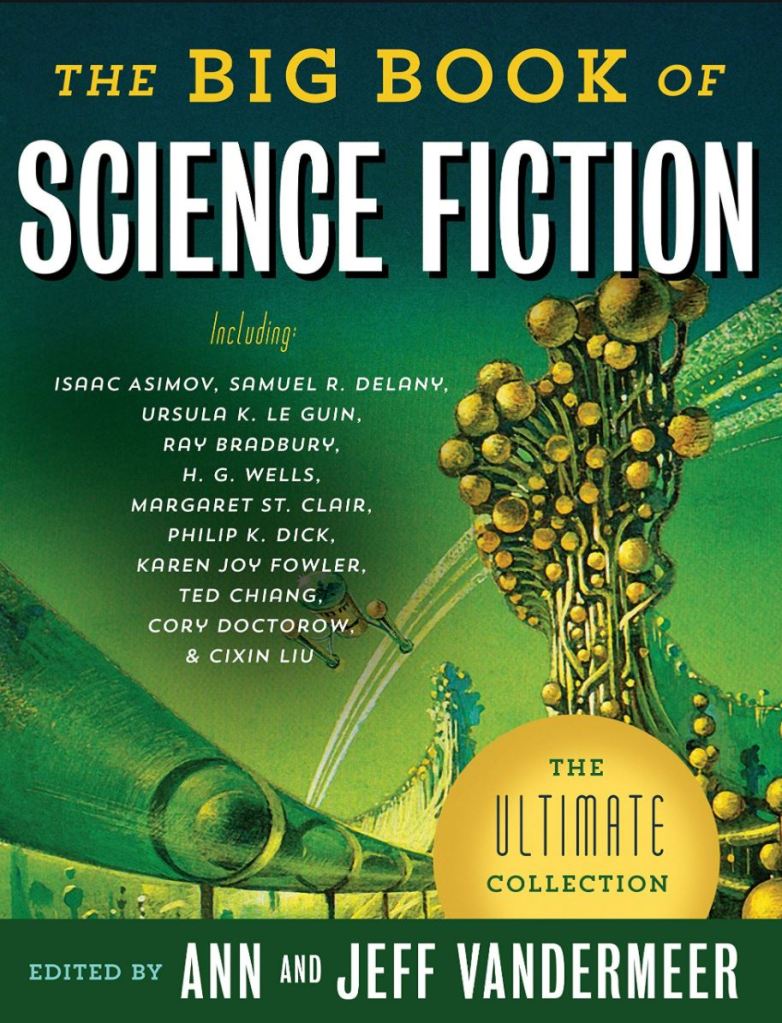Group Read 27: The Big Book of Science Fiction
Story #52, 53, 54 of 107: Three From Modern by David R. Bunch
How and why do we read old science fiction stories and novels? Our Facebook group reading of The Big Book of Science Fiction is one explanation. The VanderMeers picked stories they want to save from obscurity and published them in this anthology. Their author introductions tempt us to read other stories and novels. Most people pick books that look interesting to them at the bookstore or read books friends or famous people on television recommend. A few readers might even read stories I write about on this blog. But sometimes readers pick books on specific themes or styles.
The past is full of great stories, but then new great stories are being published all the time. We’re torn between reading the latest versus the classic. Do you ever contemplate what you read and why? Or do you merely stumble upon your next read?
Our next three selections to discuss are three sections/stories from Moderan by David R. Bunch: “No Cracks or Sagging,” “New Kings Are Not For Laughing,” and “The Flesh Man From Far Wide.” The last appeared in the November 1959 issue of Amazing Stories, but the other two might have been written for the book, which first appeared in 1971. Evidently, Bunch was working on this weird theme for a very long time.
There is a new 2018 edition of Moderan from the prestigious New York Review of Books that contains an introduction by Jeff VanderMeer. That might explain why the VanderMeers chose to include three stories by Bunch for our anthology. It’s kind of significant that NYRB reprinted this book. Here’s their sales blurb for it:
Welcome to Moderan, world of the future. Here perpetual war is waged by furious masters fighting from Strongholds well stocked with “arsenals of fear” and everyone is enamored with hate. The devastated earth is coated by vast sheets of gray plastic, while humans vie to replace more and more of their own “soft parts” with steel. What need is there for nature when trees and flowers can be pushed up through holes in the plastic? Who requires human companionship when new-metal mistresses are waiting? But even a Stronghold master can doubt the catechism of Moderan. Wanderers, poets, and his own children pay visits, proving that another world is possible.
“As if Whitman and Nietzsche had collaborated,” wrote Brian Aldiss of David R. Bunch’s work. Originally published in science-fiction magazines in the 1960s and ’70s, these mordant stories, though passionately sought by collectors, have been unavailable in a single volume for close to half a century. Like Anthony Burgess in A Clockwork Orange, Bunch coined a mind-bending new vocabulary. He sought not to divert readers from the horror of modernity but to make us face it squarely.
This volume includes eleven previously uncollected Moderan stories.
What’s kind of funny is while I was researching Moderan, I discovered I owned a Kindle copy of the NYRB edition, which I haven’t read, and probably picked up as a $1.99 bargain book. I wish I could reprint VanderMeer’s introduction. However, you can read it by going to the Look Inside feature at Amazon.
Obviously, some people think this book is special, but my reading of these three sections has only mildly interested me. Reading the hype and history of the book intrigues me more, so I might be tempted to read the entire fix-up novel. I’d be even more likely if there was an audiobook edition, but there’s not. I tend to get into iffy books easier when I’m listening and a good narrator is helping me out.
Moderan first appeared fifty years ago. It was quirky then, written for a quirky time. We live in a much different time and quirky in a much different way. We live in what’s some people are calling the Post Doom era. That catchphrase merely means civilization is on the decline, and we’re already suffering climate change. The advocates for this philosophy suggest instead of hoping society will change and do something to avoid climate catastrophes, that we should start adapting to the new reality. This is an interesting concept for science fiction readers. Instead of reading endless Max Max post-apocalyptic futures, or scenarios of escaping Earth into space, imagine futures where we hunker down and endure.
Moderan is a book about post-civilization, thus making it timely for today’s readers. But will it resonate with them? Unfortunately, I think not. It’s too far future-ish. It’s told in an almost allegorical style. And it’s not literary enough, in my opinion, to widely appeal to readers of eccentric works. I believe being so long out-of-print attests to that.
Moderan imagines a post-civilization of cyborgs and mechanical beings, but not a realistic one. It doesn’t work as science-fictional speculation or extrapolation, thus making it a kind of odd fantasy world. Thus I believe its appeal is going to be limited. I imagine readers who love outré fictional worlds, such as the novels by Mervyn Peake or the short stories of R. A. Lafferty could enjoy Moderan. That kind of fiction only works for me when I’m in rare strange reading moods.
Yet, thinking about this book makes me think about post-civilization novels. I’m afraid science fiction hasn’t done a very good job of imagining the real possibilities. The only works I can think of are recent novels by Kim Stanley Robinson, especially New York 2140 and The Ministry of the Future.
Because we’ve actually entered into a post-civilization phase I have to wonder how readers will react to all the old science fiction that imagined a much different post-civilization existence? Science fiction has produced endless speculations, but now that we opened Schrödinger’s box and reality is gelling on what will be, will science fiction change course?
Main Page of Group Read
James Wallace Harris, 12/1/21



























